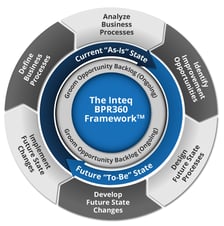A fatal rookie mistake that business analysts (BAs) sometimes make is conflating mapping and understanding the current state of a business processes with identifying candidate opportunities to improve a process. These are two of six distinct discrete iterative phases of Business Process Reengineering (BPR) and they do not mix well.
 Also see Inteq’s BPR360/Framework™ and the six iterative phases of Business Process Reengineering.
Also see Inteq’s BPR360/Framework™ and the six iterative phases of Business Process Reengineering.
The Current State of the Current State
In mapping and analyzing the current state of a business process the focus is simply (although it’s not simple) to capture the current state of a business process (work activities, workflows, decision points, underlying procedures and business rules, etc.) as its currently performed. Then, once you (in the role of a BA) have a solid verified (by the SMEs and other stakeholders) understanding of the current state, we can then authentically analyze and identify candidate opportunities to improve the process.
Here is a classic example of combining / conflating these phases. A Business Analyst (BA) is conducting a meeting or facilitated session with a group of knowledgeable Subject Matter Experts (SMEs). While mapping the current state the BA throws out an idea for “improving” the process. Something like “It looks like you perform these two activities in serial (one after another), wouldn’t it be better to reorganize the workflow to perform these two activities in parallel?”
The Fatal Mistake
What the BA just did was suggest a potential change in the process flow – possibly and improvement, possibly not – while still trying to understand the current state of the process. The BA has not yet established the veracity of the current state of the process and has not yet had the current validated by the SMEs. The BA does not yet have the authenticity/legitimacy of understanding nor the confidence of the SMEs to start pitching suggestions for improving the processes.
There are three potential scenarios of this type of behavior (i.e., pitching improvement ideas before understanding the current state) – and all three of the scenario outcomes are bad!
Scenario #1: The BAs idea is a good idea. So, what’s the issue if the BAs idea is a good idea? Based on my experience, if the BAs idea is a good idea at this stage of analysis, there is a 99%+ chance that someone else already had that idea before the BA had that idea. Who is that someone else? Yes, you probably guessed it correctly, the someone else is one (or more) of the SMEs that are in the session with the BA.
The recording that starts playing in that SME’s mind is “yea, that’s an excellent idea and as a matter of fact I came up with that same idea several times over the past few years during other improvement initiatives and it never went anywhere. So, it’s not cool that you [the BA] get credit for the good idea that I [the SME] came up with before you [the BA] came up with it.”
Remember, this is what the SME is thinking in their mind – the SME is not saying it out loud. The SME might be outwardly nodding that it’s a good idea, but the SME is irritated with the BA. Accordingly, the SME starts tuning out for the remainder of the session and the SME not coming back for subsequent sessions. And this is the best of the three bad outcomes.
Scenario #2: The BA’s idea is a stupid idea. Unlike in scenario #1 where the BA’s idea was a good idea, in scenario #2, the BA’s idea is a stupid idea. The question is who knows it’s a stupid idea and who does not know it’s a stupid idea? Yes, once again, you probably guessed it correctly, at least one and probably all of the SME’s know it’s a stupid idea, but the BA is clueless that it’s a stupid idea.
The SMEs are irritated. The recording that starts playing in the SMEs minds is “this is a really stupid idea, but you [the BA] does not know that it’s a stupid idea because you have not taken the time to understand our process and the reason(s) that we do this thing in the way that we are doing it.” The SMEs lose respect for the BA and like scenario #1, they start tuning out for the remainder of the session and they are not coming back for subsequent sessions.
Scenarios #3: An SME does not like the BA. It’s typically deeper than that. The SME is irritated to be in the session, perhaps irritated with their colleagues and their manager and the organization as a whole. This type of SME is what I classify as an organizational sniper – they are thrilled to shoot holes in your idea, but they wait for the most impactful time to shoot holes in an idea.
It often manifests as something like this – the SME says to the BA “I think you are on to something with that idea [the stupid idea] why not present it in the next full working group meeting.” The SME sniper is setting the BA up for failure. The BA brings up the idea in the next full working group meeting and the SME sniper shoots holes in the idea in front of the full working group. The BAs reputation and effectiveness in the project is tarnished.
Best Practice Tip
Its ok to ask legitimate clarifying questions such as “I just want to confirm that these two activities are performed in sequence one after another, is that correct?” Just ensure that you ask the question in a sincere clarifying tone, not a tone that begs the question, from an SME perspective, that the way the SME are currently doing it is not the best way.
All three scenarios above can be avoided by simply first focusing on getting the current state right by engaging with the SMEs in high quality current state conversations, running scenarios with the SMEs to confirm and validate the current state, keeping the conversation focused on the current state without jumping to potential future state opportunities. The key is to focus on mapping and understanding the current as-is state of a process as it is actually performed, not how you [in the role of a BA] think it should be performed.
Then, when you have confirmation and alignment with the SMEs regarding the veracity of the current state, you can turn your attention to collaborating with the SMEs and other stakeholders to analyze the current state to identify opportunities to improve the process to move forward to an more effective, efficient, agile future state. I discuss these concepts in more detail in my Business Process Modeling and Business Systems Analysis course.
If you found this post helpful, you might also find these two white papers valuable in advancing your business analysis skills and techniques: 10 Perilous Misconceptions of Censuring Current State Mapping & Analysis and The 5 Essential Business Analysis Questions.
Subscribe to my blog | Visit our Knowledge Hub
Visit my YouTube channel | Connect with me on LinkedIn
Check out our Business Analysis Training Courses and Consulting Services




















